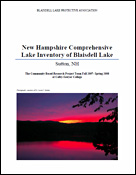
New Hampshire Comprehensive Lake Inventory of Blaisdell Lake
This report is a collection of information and analysis about the characteristics and conditions of the Blaisdell Lake watershed. The purpose of compiling this information was to provide the Blaisdell Lake Protective Association (BLPA) with useful information to be referenced in the creation of future management plans for the watershed.
This report was completed through a cooperative relationship between the Institute for Community and Environment at Colby-Sawyer College and the BLPA. This information was collected between September 2007 and April 2008.
The primary goal at the beginning of this project was to complete a Comprehensive Lake Inventory created by the New Hampshire Department of Environmental Services. The inventory presents an array of in-depth questions and answers about many different characteristics pertaining to the lake system. It also provides an objective rating of the current status of Blaisdell Lake.
Overall the health of the lake is good, although there are a couple of areas of concern that will be important to address in order to ensure that it remains good. Because the Russell Pond stream has had high conductivity readings for a number of years, we tested other perennial and intermittent streams to see if there were other 'hot spots.” We found another stream with high conductivity readings near the beach. We do not have an explanation for the high readings in the Russell Pond stream, it appears that the location near the beach is influenced by the road, and possibly by road salt.
Region-wide there has been a significant amount of development in shorelands and along ridgelines near waterbodies. The Blaisdell Lake watershed is not exempt from this trend, and you have witnessed some recent development in your shoreland and less in the watershed. It will become increasingly important to educate property owners as to the importance of limiting the amount of impervious surface in the watershed, and utilizing best management practices when building does take place. Additionally, conservation efforts focused in the watershed will help protect water quality.
There is some very good news in the lake inventory as well. The fact that Blaisdell Lake has no milfoil is no doubt tied to the vigilance of your Lake Hosts, and continued monitoring is important given that it is present in nearby lakes.
There are three areas related to water quality in which we did additional work beyond the scope of the Comprehensive Lake Inventory: Water chemistry testing (including conductivity, turbidity, pH, and flow-rate data pertaining to spring run-off), impervious surface, and conservation priorities for the watershed. We did this because each of these areas can be instrumental in affecting the water quality of Blaisdell Lake.



